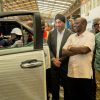 About 30 years ago, in 1977, Kenya-based Associated Vehicle Assemblers (AVA) Ltd introduced its first line of passenger vehicles, the Toyota Hilux. The vehicle became one of the success stories in Kenya’s vehicle assembly industry.
About 30 years ago, in 1977, Kenya-based Associated Vehicle Assemblers (AVA) Ltd introduced its first line of passenger vehicles, the Toyota Hilux. The vehicle became one of the success stories in Kenya’s vehicle assembly industry.
But all this took a turn for the worse in 1993, when the government relaxed rules on importation of used vehicles, sending sales of Toyota Hilux south. By 1998, and with the market flooded with cheaper imports from Japan, production stopped.
Not so many have witnessed this rise and fall as has Dave Williamson, the AVA factory manager, who welcomed Kenya’s founding president Jomo Kenyatta when he opened the assembly in 1977.
“I have seen the auto assembly sector grow. I have seen the sector prosper. I have seen us struggle to stay afloat,” Mr Williamson told The EastAfrican at his offices in Miritini, Mombasa.
“At its peak, our plant in Mombasa would produce 10,000 units. At the time, the country had strict controls on the importation of motor vehicles, with those seeking to bring in vehicles requiring permits signed by us, the vehicles assemblers. We got to a point where we were making more passenger cars than commercial vehicles. We were headed in the right direction,” he added.
Falling numbers
Today, the plant produces an average of 6,000 vehicles annually bogged down by high production costs and lack of incentives from the government.
When the plant was set up, it was meant to assemble vehicles for the export market. It thrived while the market was closed to imports from Japan and the Middle East.
But in recent times, governments in the region have maintained bottlenecks, much to the disadvantage of new vehicle manufacture.
In Kenya, the region’s biggest market for new vehicles, the sales of new motor vehicles has dropped by more than 40 per cent in the past three years, to 11,044 units last year, with major dealers like Isuzu East Africa and Toyota Kenya recording reduced orders.
According to data from the Kenya Motor Industry Association, these dealers have seen the sales fall from a high of 19,966 vehicles in 2015 — the peak year — to 13,869 units in 2016.
In a recent interview, KMI’s chairperson Rita Kavashe, who is also the chief executive of Isuzu East Africa, blamed this decline on the reduced economic activity brought about by tighter credit markets and political uncertainty in the recent general election.
“The sales bottomed out last year and are forecast to rise by up to 10 per cent this year,” she said.
Nearly all the dealers: Isuzu, Toyota Kenya and Simba Corporation — which sells BMW cars and Mitsubishi trucks and other brands — recorded reduced orders last year.
Market leader Isuzu’s sales dropped from 4,858 in 2016 to 3,940 in 2017, while the orders for its top rival Toyota, including Hino buses and trucks, fell from 2,778 to 2,508 over the same period.
Simba Motors’ sales declined from 2,343 to 1,785. Toyota, Hino and Mitsubishi trucks are assembled at the AVA plant in Mombasa.
Major auto manufacturers
Despite the fall in volumes, things are looking up for the region’s vehicle assembly industry with the recent entry of major auto manufacturers — Japanese giant Toyota in 2015, Germany’s Volkswagen (2016) and France’s PSA Group, the maker of Peugeot in 2016.
By the end of June, Volvo Trucks of Sweden is expected to unveil its $25 million vehicle assembly plant at the AVA plant in Mombasa, following its partnership with NECST Motors. India’s Ashok Leyland is also planning to set up an assembly plant in Kenya.
This new interest opens up the region to secondary business opportunities, job creation and technology transfer as these auto makers bring with them spare parts business, third party supply contracts and dealership opportunities.
This is supported by friendlier government incentives like the case in Rwanda, which offered Volkswagen South Africa tax exemptions and friendlier policies.
“These kinds of investors are looking for long-term opportunities that are safeguarded by policies. Commercially, they are not going to move in and invest unless they know the government is going to support them for the next 10, 20 or even 30 years.
“Otherwise, they’ll head to another market where there isn’t any risk,” Mr. Williamson said.
Govt policy
Sun Qingzhong, general manager of Foton Motor Kenya, which launched its first assembled trucks at the AVA plant in January, concurs with this thought saying they were attracted by the change in government policy, especially on leasing new vehicles.
“With this new plant, we will also provide spare parts, after-sales services which will create more job opportunities, contribute to the development of regional economy,” Mr Qingzhong.
In January, VW confirmed it would be investing $20 million in a new vehicle assembly plant to produce three car models and car rental services in Rwanda, with the first vehicle expected to come off the assembly line by June.
This venture, with an installed production capacity of 5,000 units, would also provide a new avenue for used cars for businesses, through a car rental business.
“The investment is set to be rolled out in three phases, with the consequent phases seeing the firm increase production capacity, car models, employees, scale up the mobility solutions and possibility of exports,” Thomas Schafer, the chief executive of Volkswagen South Africa said.
The big question, however, remains: What strategy will these new entrants employ? The likes of Isuzu and Toyota Kenya have benefitted from government contracts which have sustained their models. Volkswagen, on the other hand, is trying out a car hailing and rental service.
“We hope to have our locally made cars serve to gradually phase out used imports in the region. We will also rope in the corporates on our car renting programme,” Mr Schafer said.
For these assemblers, government business has been an attractive factor in this market with Kenya alone leasing more than 4,500 vehicles over the past six years.
This could get a boost when a new leasing contract worth $134.7 million comes into effect later next month as Kenya starts the second phase of the government leasing programme that will see more than 1,380 units leased to various government departments.
It is also expected that the now used 2,700 vehicles previously leased four years ago for $67 million will find their way into the country’s used car market as Treasury angles to use this a method to push down the country’s high import bill that has been propelled by the used car market.
However, Vaell regional managing director Paul Njeru says that this would be bad idea given that some of these vehicles from new vehicle dealers and assemblers could be too expensive for the local market.
“We have also seen most vehicles having a very low mileage of which if the government extended the lease, they would save the taxpayers a lot of money. An extension of a few years would allow the vehicles to be sold at near residual value in future to a ready market,” Mr Njeru said.






